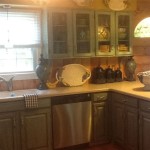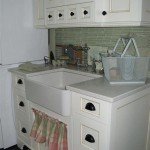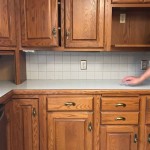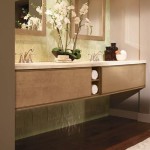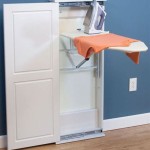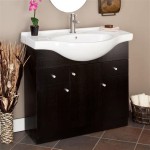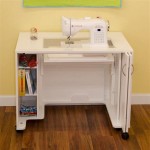How To Get Grease Off Top Of Kitchen Cabinets
The accumulation of grease on top of kitchen cabinets is a common household problem. Cooking fumes containing oils and fats circulate throughout the kitchen, gradually settling on surfaces, especially those located higher up. This build-up can be unsightly and, if left unattended for extended periods, can become incredibly difficult to remove. Understanding the composition of this grease and employing appropriate cleaning techniques are crucial for effective removal and maintaining the cleanliness of the kitchen.
Grease, in this context, is not pure fat. It is a complex mixture comprising cooking oils, airborne dust, food particles, and even moisture. The heat generated during cooking processes causes these components to vaporize and circulate. As these vapors cool, they condense on surfaces, creating a sticky, often hardened layer. Over time, this layer attracts more dust and debris, further solidifying the grime. The type of cooking practices employed significantly impacts the speed and extent of grease build-up. For instance, frequent frying or deep-fat cooking tends to generate more airborne grease than baking or steaming.
Regular cleaning is the most effective way to prevent the accumulation of stubborn grease on kitchen cabinets. A quick wipe down with a damp cloth or sponge every week can prevent the grease from hardening and becoming difficult to remove. However, when grease has already built up, more aggressive cleaning methods are required. The effectiveness of these methods depends on the type of cabinet material, the age and thickness of the grease layer, and the cleaning agents used.
Before beginning any cleaning process, it is essential to consider the type of material the kitchen cabinets are made from. Common cabinet materials include wood, laminate, and metal. Each material requires a different approach to avoid damage. Using harsh chemicals or abrasive cleaners on wood cabinets, for example, can strip the finish or even damage the wood itself. Similarly, laminate cabinets can be scratched or discolored by certain cleaning agents. Metal cabinets, while generally more durable, can still be susceptible to rust or corrosion if exposed to harsh chemicals for extended periods.
Prior to applying any cleaning solution to the entire surface, perform a spot test in an inconspicuous area. This allows for the assessment of any potential damage or discoloration that the cleaner might cause. Choose an area inside a cabinet or on a less visible part of the top of the cabinet. Apply a small amount of the cleaning solution, let it sit for a few minutes, and then wipe it clean. Observe the area for any adverse reactions before proceeding with the cleaning process on the entire surface.
Key Point 1: Preparing For The Cleaning Process
Before starting the cleaning process, gather the necessary supplies. This includes a bucket, warm water, a cleaning solution (either a commercially available degreaser or a homemade solution), a non-abrasive sponge or cloth, a soft-bristled brush (optional, for stubborn areas), rubber gloves, and paper towels or a clean, dry cloth for drying the cabinets. Having all the supplies readily available will streamline the cleaning process and ensure efficiency.
Ventilation is another crucial aspect to consider. Opening windows and doors or turning on the kitchen exhaust fan will help to remove fumes from the cleaning solutions and ensure proper airflow. This is particularly important when using strong degreasers or chemical-based cleaners. Adequate ventilation will also help to prevent the build-up of moisture, which can contribute to the growth of mold and mildew.
Protecting the surrounding areas is essential to prevent damage or staining. Cover the countertops, stovetop, and any other surfaces that might be exposed to drips or splashes from the cleaning solution. Using plastic sheeting or old towels can provide adequate protection. This preventative measure will save time and effort in cleaning up after the cabinet cleaning process is complete.
Removing any items that are stored on top of the cabinets is also important. This will provide unobstructed access to the entire surface and prevent the items from becoming contaminated with the cleaning solution. Items such as decorative baskets, cookbooks, or appliances should be carefully removed and placed in a safe area away from the cleaning zone.
Key Point 2: Cleaning Solutions & Techniques
Several cleaning solutions can be used to remove grease from kitchen cabinets. Commercial degreasers are specifically formulated to dissolve grease and grime. These products are readily available at most grocery stores and home improvement centers. When using a commercial degreaser, it is essential to follow the manufacturer's instructions carefully. Some degreasers may require dilution with water, while others can be used undiluted. Always wear rubber gloves when handling chemical-based cleaners to protect the skin.
A homemade cleaning solution consisting of warm water and dish soap can also be effective for removing grease. This is a gentler option compared to commercial degreasers and is less likely to damage the cabinet finish. Mix a few drops of dish soap into a bucket of warm water and use a sponge or cloth to apply the solution to the cabinets. Rinse thoroughly with clean water and dry with a clean cloth.
For more stubborn grease deposits, a baking soda paste can be used. Baking soda is a mild abrasive that can help to loosen and remove hardened grease. Mix baking soda with water to form a thick paste and apply it to the affected areas. Let the paste sit for a few minutes to allow it to penetrate the grease, and then gently scrub with a non-abrasive sponge or cloth. Rinse thoroughly with clean water and dry with a clean cloth. Avoid using excessive force when scrubbing, as this can scratch the cabinet finish.
Another effective homemade cleaning solution involves vinegar and water. Vinegar is a natural degreaser and disinfectant, and it can help to dissolve grease and remove odors. Mix equal parts of white vinegar and warm water in a spray bottle and spray the solution onto the cabinets. Let it sit for a few minutes, and then wipe clean with a damp cloth. Vinegar can have a strong odor, so it is important to ensure adequate ventilation during the cleaning process.
Regardless of the cleaning solution used, the application technique is crucial for effective grease removal. Apply the solution to the sponge or cloth, rather than directly to the cabinet surface. This will help to prevent drips and streaks. Wipe the cabinets in a circular motion, applying gentle pressure to loosen the grease. For particularly stubborn areas, allow the cleaning solution to sit on the grease for a few minutes before wiping. Rinse the sponge or cloth frequently with clean water to remove any accumulated grease and grime.
Key Point 3: Post-Cleaning & Maintenance
After cleaning the cabinets, it is important to thoroughly rinse them with clean water to remove any residue from the cleaning solution. Use a clean sponge or cloth to wipe down the cabinets with water, ensuring that all traces of the cleaning solution are removed. Residue from cleaning solutions can attract dust and grime, leading to a faster build-up of grease in the future.
Drying the cabinets immediately after rinsing is essential to prevent water spots and streaks. Use a clean, dry cloth or paper towels to wipe down the cabinets, removing any excess moisture. Drying the cabinets will also help to prevent the growth of mold and mildew, especially in humid environments.
Consider applying a protective coating to the cabinets after cleaning to help prevent future grease accumulation. A thin layer of furniture polish or wax can create a barrier that makes it easier to wipe away grease and grime. Follow the manufacturer's instructions carefully when applying these products, and avoid using excessive amounts, as this can create a sticky residue.
Regular maintenance is the key to preventing the build-up of stubborn grease on kitchen cabinets. Wipe down the cabinets with a damp cloth or sponge every week to remove any fresh grease deposits. This simple task will prevent the grease from hardening and becoming difficult to remove over time. Also, consider using a kitchen exhaust fan while cooking to vent grease-laden fumes outside. This will drastically reduce the amount of grease that settles on the cabinets.
In addition to regular cleaning, consider using shelf liner on top of the cabinets. Shelf liner can provide a protective barrier against grease and dust, making it easier to clean the cabinets in the future. Simply replace the shelf liner periodically to maintain a clean surface. Choose a shelf liner that is easy to clean and resistant to grease and moisture.
Finally, be mindful of cooking practices. Try to minimize frying and deep-fat cooking, as these methods generate more airborne grease. If frying is necessary, use a splatter screen to prevent grease from splattering onto the cabinets. Also, clean up any spills or splatters immediately to prevent them from hardening and becoming difficult to remove.

How To Remove Grease From Kitchen Cabinets 3 Methods Bob Vila

How To Clean The Top Of Kitchen Cupboards 4 Simple Steps Everyday Old House

How To Clean The Tops Of Greasy Kitchen Cabinets Secret Tip My Pinterventures

How To Clean Sticky Grease Off Kitchen Cabinets Ovenclean

How To Clean Sticky Grease Off Kitchen Cabinets

How To Clean The Top Of Kitchen Cupboards 4 Simple Steps Everyday Old House

How To Clean The Top Of Kitchen Cupboards 4 Simple Steps Everyday Old House

How To Clean Painted Kitchen Cabinets By Kayla Payne

How To Deep Clean Kitchen Cabinets And Keep Them Looking Gorgeous Everyday Skate

3 Super Easy Ways To Clean White Kitchen Cabinets And Avoid
Related Posts

